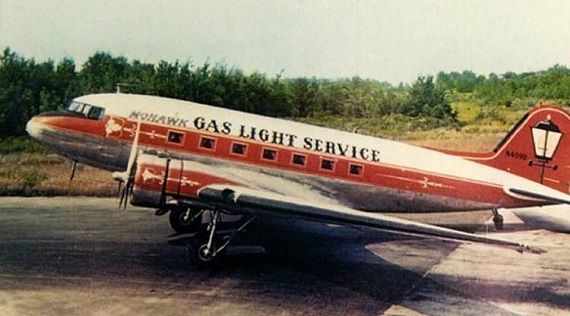No, this isn’t a story about the famous (some might say infamous) “Mile High Club.” It’s about promotions cooked up by the airlines to boost sales by selling sex.
Flying Brothels

Mohawk Airlines’ Gas Light service.
The bawdy ball was kicked off in 1960 by Utica, N.Y.-based Mohawk Airlines. At the time, the carrier was transitioning to an all-jet-powered fleet, having sold all but two of its World War II-vintage DC-3 prop planes. Mohawk hyped its fleet upgrade by redecorating the cabins of the two DC-3s to look like what the airline euphemistically called “Victorian-style” parlors – but which looked more like turn-of-the-century styled flying brothels.
Creating a bawdyish ambiance were touches like gold filigreed wallpaper lining the planes’ cabins, red velvet curtains with gold tassels over the windows and interior lighting by carriage lamps. Still another touch was added by stewardesses (as flight attendants were called back then) dressed like old-time hookers who served free beer, cheese, pretzels and cigars.

Mohawk used its last two DC3s for the Gas Light promotion.
Mohawk, which mainly flew to cities scattered over northern New England, got lots of national publicity on what were officially named “Gas Light Flights” (although most reporters used more colorful tags). As a result, passengers reportedly packed the two planes often totally filling them up, according to a Mohawk spokesman.
The last DC-3 found a new home a little over a year and a half later. But Mohawk – despite the overwhelming success of its promotion – didn’t repeat it. Nor was it copied by other airlines, because after the Gas Light Flights bit the dust the FAA safety agency enacted new flammability rules for airline cabins banning things that burned fast like wallpaper and velvet curtains.
The ‘Air Strip’
Fast-forward a few years to the mid-60s when Braniff International brought sex back to the skies with its famous/infamous “Pucci Air Strip.” In TV ads, a shapely hostess (as Braniff called its flight attendants) casually stripped off layers of her uniform, unveiling different layers – and progressively more skin – against a backdrop of burlesque music and a narrator using subtle sexual references ending with the tag line, “(Braniff) believes that even an airline hostess should look like a girl.”

The promotion won all kinds of ad awards, but it went over like a lead balloon with women’s groups like the National Organization for Women, founded in 1966 (perhaps not coincidentally right after the Braniff promotion debuted).
I’m Cheryl, Fly Me
Fast forward again, this time to 1971 when National Airlines resurrected the sex-sells- seats angle in its double-entendred campaign, “Fly Me.” This one spotlighted gorgeous flight attendants (as they were known by then) using their first names in ads saying “I’m Cheryl. Fly me” or “I’m Linda. Fly me.” Flight attendants even had to wear “Fly Me” buttons on their uniforms
Denying a saucy twist to the promotion, a National spokesman said “We had no preconceived idea of injecting a suggestive leer into the campaign."

Passengers reportedly loved Fly Me – so much that the company claimed it upped ridership by a whopping 23 percent in the first year alone. But most of National’s flight attendants hated it. (One attendant reportedly sketched in the words “Go fly yourself” on her uniform’s campaign button.)
Moving Tails
Some three years later, as passengers started tiring of Fly Me, the sex-in-the-skies concept popped up again, this time in Continental Airlines’ famous/infamous “We really move our tail for you campaign. Again, the airline claimed it paid off, while its flight attendants grumbled. In Los Angeles, Continental’s home town, they wrangled a feature story in a major newspaper in which an attendant, pictured with a cute little tot in her lap, accused the company of treating its cabin staff like sex symbols.
Where are they now? After a series of mergers, acquisitions and the like, what was left of Mohawk ended up flying under the colors of American Airlines. National was acquired by Pan Am, which later was sold off piece by piece until its bones were purchased by Delta. Continental merged with United and now zips through the friendly skies under United’s name. Braniff folded its wings and remains just an airline legend despite numerous attempts to get it back up in the air.
Disclosure: The writer was Mohawk's public relations chief for a few years in the 1960s.
